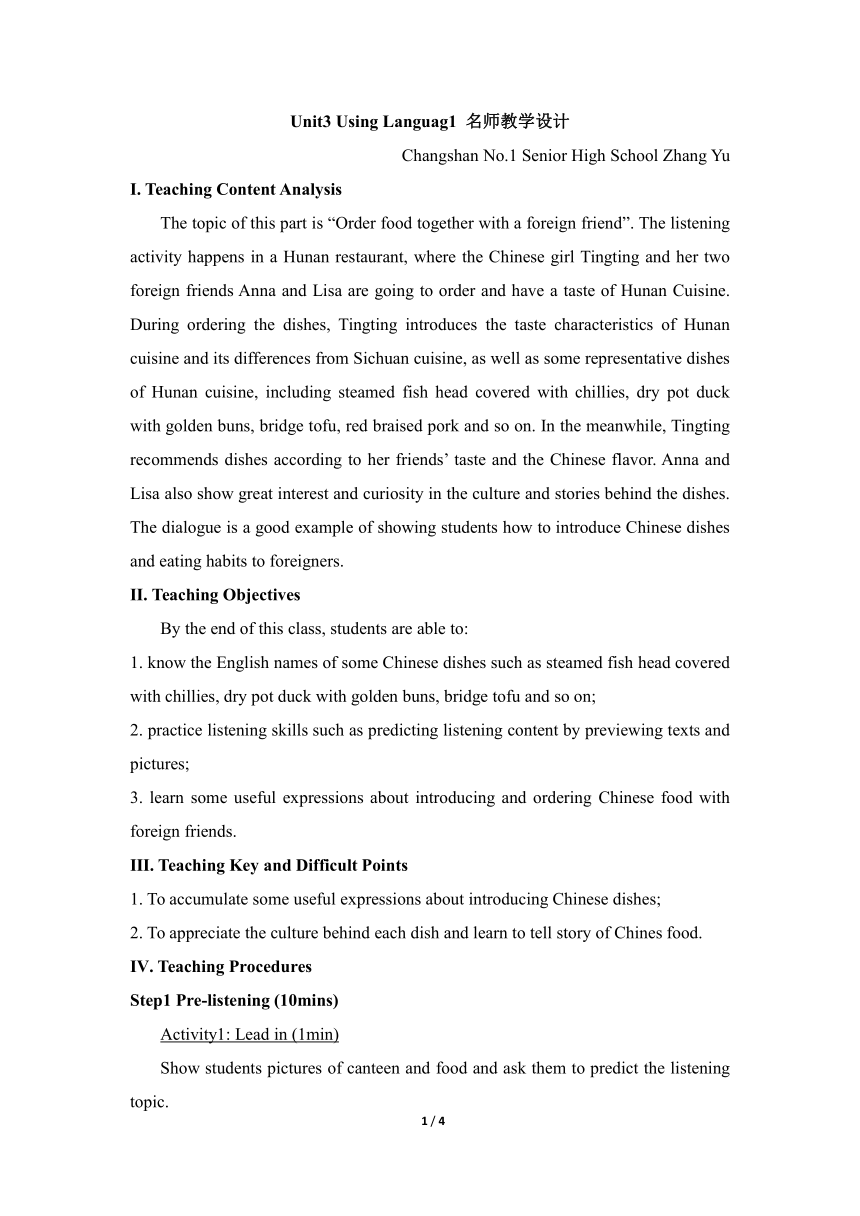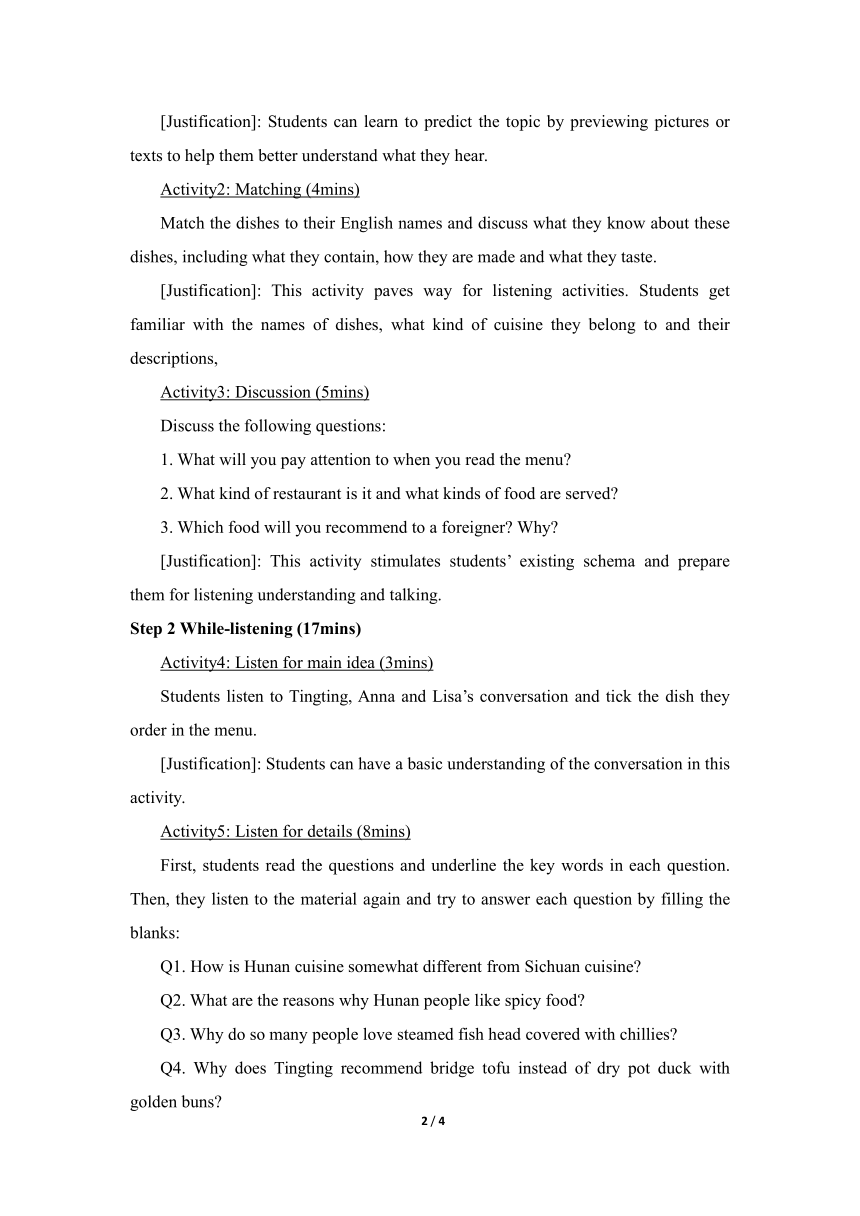人教版(2019)高中英语选择性必修第二册 Unit3 Food and Culture Using Languag1 名师教学设计
文档属性
| 名称 | 人教版(2019)高中英语选择性必修第二册 Unit3 Food and Culture Using Languag1 名师教学设计 |  | |
| 格式 | docx | ||
| 文件大小 | 15.6KB | ||
| 资源类型 | 教案 | ||
| 版本资源 | 人教版(2019) | ||
| 科目 | 英语 | ||
| 更新时间 | 2023-03-12 15:52:24 | ||
图片预览


文档简介
Unit3 Using Languag1 名师教学设计
Changshan No.1 Senior High School Zhang Yu
Ⅰ. Teaching Content Analysis
The topic of this part is “Order food together with a foreign friend”. The listening activity happens in a Hunan restaurant, where the Chinese girl Tingting and her two foreign friends Anna and Lisa are going to order and have a taste of Hunan Cuisine. During ordering the dishes, Tingting introduces the taste characteristics of Hunan cuisine and its differences from Sichuan cuisine, as well as some representative dishes of Hunan cuisine, including steamed fish head covered with chillies, dry pot duck with golden buns, bridge tofu, red braised pork and so on. In the meanwhile, Tingting recommends dishes according to her friends’ taste and the Chinese flavor. Anna and Lisa also show great interest and curiosity in the culture and stories behind the dishes. The dialogue is a good example of showing students how to introduce Chinese dishes and eating habits to foreigners.
Ⅱ. Teaching Objectives
By the end of this class, students are able to:
1. know the English names of some Chinese dishes such as steamed fish head covered with chillies, dry pot duck with golden buns, bridge tofu and so on;
2. practice listening skills such as predicting listening content by previewing texts and pictures;
3. learn some useful expressions about introducing and ordering Chinese food with foreign friends.
Ⅲ. Teaching Key and Difficult Points
1. To accumulate some useful expressions about introducing Chinese dishes;
2. To appreciate the culture behind each dish and learn to tell story of Chines food.
Ⅳ. Teaching Procedures
Step1 Pre-listening (10mins)
Activity1: Lead in (1min)
Show students pictures of canteen and food and ask them to predict the listening topic.
[Justification]: Students can learn to predict the topic by previewing pictures or texts to help them better understand what they hear.
Activity2: Matching (4mins)
Match the dishes to their English names and discuss what they know about these dishes, including what they contain, how they are made and what they taste.
[Justification]: This activity paves way for listening activities. Students get familiar with the names of dishes, what kind of cuisine they belong to and their descriptions,
Activity3: Discussion (5mins)
Discuss the following questions:
1. What will you pay attention to when you read the menu
2. What kind of restaurant is it and what kinds of food are served
3. Which food will you recommend to a foreigner Why
[Justification]: This activity stimulates students’ existing schema and prepare them for listening understanding and talking.
Step 2 While-listening (17mins)
Activity4: Listen for main idea (3mins)
Students listen to Tingting, Anna and Lisa’s conversation and tick the dish they order in the menu.
[Justification]: Students can have a basic understanding of the conversation in this activity.
Activity5: Listen for details (8mins)
First, students read the questions and underline the key words in each question. Then, they listen to the material again and try to answer each question by filling the blanks:
Q1. How is Hunan cuisine somewhat different from Sichuan cuisine
Q2. What are the reasons why Hunan people like spicy food
Q3. Why do so many people love steamed fish head covered with chillies
Q4. Why does Tingting recommend bridge tofu instead of dry pot duck with golden buns
Q5. Why is red braised pork the most famous dish
[Justification]: Reading the questions and underlining the key words is an essential step in detailed listening because students can know the important information before listening and adjust their attention during listening. Answering questions by filling blanks simplifies the task so students can get the answer quickly.
Activity6: Listen for expressions (6mins)
Students are asked to listen to the material for the third time and try to find out the answers of these two questions:
1. What language did they use to order food
2. What language did they use to introduce food
[Justification]: This activity is designed to build language scaffold for students. They can accumulate useful expressions about introducing and ordering food from the listening material, which also paves way for the talking part.
Step 3 Talking (13mins)
Activity 7: Role-playing (9mins)
In groups of three, students take turns role-playing taking their foreign guest to the restaurant they have chosen. One of them should act as the foreign guest, one as the Chinese host, and one as the waiter or waitress. Teacher shows students relevant expression for their references, including: ordering food, introducing food and paying the bill. Teacher invites several groups to show in class and makes comments on their conversation. After that, teacher shows possible version of the conversation and highlight some good expressions.
[Justification]: Students are able to use these expressions to make a conversation.
Activity 8: Thinking (4mins)
Ask students to think about this question: Is it a good idea to bring your foreign friend to a Chinese restaurant to have a taste of the Chinese food
Voice your opinion and state your reasons by examples.
[Justification]: This activity develops students’ critical thinking and deepens their understanding of cuisine and culture.
Step 4 Homework
Search online for more descriptions of Chines cuisine and
2 / 2
Changshan No.1 Senior High School Zhang Yu
Ⅰ. Teaching Content Analysis
The topic of this part is “Order food together with a foreign friend”. The listening activity happens in a Hunan restaurant, where the Chinese girl Tingting and her two foreign friends Anna and Lisa are going to order and have a taste of Hunan Cuisine. During ordering the dishes, Tingting introduces the taste characteristics of Hunan cuisine and its differences from Sichuan cuisine, as well as some representative dishes of Hunan cuisine, including steamed fish head covered with chillies, dry pot duck with golden buns, bridge tofu, red braised pork and so on. In the meanwhile, Tingting recommends dishes according to her friends’ taste and the Chinese flavor. Anna and Lisa also show great interest and curiosity in the culture and stories behind the dishes. The dialogue is a good example of showing students how to introduce Chinese dishes and eating habits to foreigners.
Ⅱ. Teaching Objectives
By the end of this class, students are able to:
1. know the English names of some Chinese dishes such as steamed fish head covered with chillies, dry pot duck with golden buns, bridge tofu and so on;
2. practice listening skills such as predicting listening content by previewing texts and pictures;
3. learn some useful expressions about introducing and ordering Chinese food with foreign friends.
Ⅲ. Teaching Key and Difficult Points
1. To accumulate some useful expressions about introducing Chinese dishes;
2. To appreciate the culture behind each dish and learn to tell story of Chines food.
Ⅳ. Teaching Procedures
Step1 Pre-listening (10mins)
Activity1: Lead in (1min)
Show students pictures of canteen and food and ask them to predict the listening topic.
[Justification]: Students can learn to predict the topic by previewing pictures or texts to help them better understand what they hear.
Activity2: Matching (4mins)
Match the dishes to their English names and discuss what they know about these dishes, including what they contain, how they are made and what they taste.
[Justification]: This activity paves way for listening activities. Students get familiar with the names of dishes, what kind of cuisine they belong to and their descriptions,
Activity3: Discussion (5mins)
Discuss the following questions:
1. What will you pay attention to when you read the menu
2. What kind of restaurant is it and what kinds of food are served
3. Which food will you recommend to a foreigner Why
[Justification]: This activity stimulates students’ existing schema and prepare them for listening understanding and talking.
Step 2 While-listening (17mins)
Activity4: Listen for main idea (3mins)
Students listen to Tingting, Anna and Lisa’s conversation and tick the dish they order in the menu.
[Justification]: Students can have a basic understanding of the conversation in this activity.
Activity5: Listen for details (8mins)
First, students read the questions and underline the key words in each question. Then, they listen to the material again and try to answer each question by filling the blanks:
Q1. How is Hunan cuisine somewhat different from Sichuan cuisine
Q2. What are the reasons why Hunan people like spicy food
Q3. Why do so many people love steamed fish head covered with chillies
Q4. Why does Tingting recommend bridge tofu instead of dry pot duck with golden buns
Q5. Why is red braised pork the most famous dish
[Justification]: Reading the questions and underlining the key words is an essential step in detailed listening because students can know the important information before listening and adjust their attention during listening. Answering questions by filling blanks simplifies the task so students can get the answer quickly.
Activity6: Listen for expressions (6mins)
Students are asked to listen to the material for the third time and try to find out the answers of these two questions:
1. What language did they use to order food
2. What language did they use to introduce food
[Justification]: This activity is designed to build language scaffold for students. They can accumulate useful expressions about introducing and ordering food from the listening material, which also paves way for the talking part.
Step 3 Talking (13mins)
Activity 7: Role-playing (9mins)
In groups of three, students take turns role-playing taking their foreign guest to the restaurant they have chosen. One of them should act as the foreign guest, one as the Chinese host, and one as the waiter or waitress. Teacher shows students relevant expression for their references, including: ordering food, introducing food and paying the bill. Teacher invites several groups to show in class and makes comments on their conversation. After that, teacher shows possible version of the conversation and highlight some good expressions.
[Justification]: Students are able to use these expressions to make a conversation.
Activity 8: Thinking (4mins)
Ask students to think about this question: Is it a good idea to bring your foreign friend to a Chinese restaurant to have a taste of the Chinese food
Voice your opinion and state your reasons by examples.
[Justification]: This activity develops students’ critical thinking and deepens their understanding of cuisine and culture.
Step 4 Homework
Search online for more descriptions of Chines cuisine and
2 / 2
